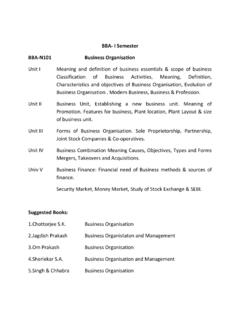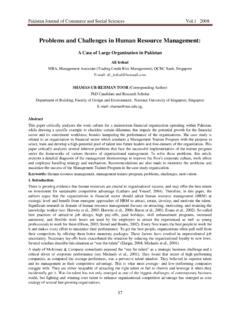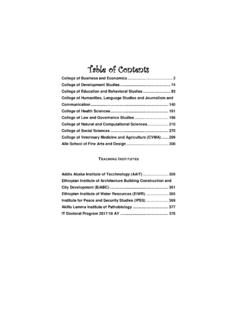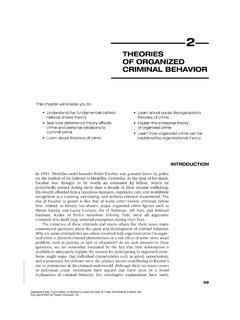Transcription of Organizational Culture Drives Ethical Behaviour: Evidence ...
1 1 Organizational Culture Drives Ethical Behaviour: Evidence From Pilot Studies Azish Filabi, Executive Director, Ethical Systems, NY, NY, USA Caterina Bulgarella, Independent Ethics Advisor & Culture Architect, NY, NY, USA Abstract Regulators around the world are increasingly focusing on Organizational Culture to help them curb corruption in companies. After the Global Financial Crisis in particular, the financial services sector regulators, both in the UK and the US, have encouraged financial institutions to report on how they manage the Culture in their organizations, and to determine ways that Culture impacts desired behaviors at the firm. In the , the sector has created a Banking Standards Board that conducts Culture assessments at member companies. In the , FINRA, the broker-dealer regulatory organization, requires that companies report on Culture , and the NY Fed, and the OCC emphasize the role that Culture plays in regulating behavior and conduct and their expectation that firms actively manage their Culture , and require reporting in some cases.
2 In 2016 and 2017, a team of researchers collaborating with Ethical Systems, a research collaboration housed at the NYU-Stern School of Business, came together to determine the appropriate constructs for what constitutes Ethical Culture . The results of that work are described in this paper, including the development of a data-driven framework for Ethical Culture in organizations. 2 The framework is an analog to Herzberg s two-factor theory, which is a simple model that describes the positive and negative continuums on which individuals express workplace attitudes. Applied to Ethical Culture , the research shows that there are both positive aspects of an Ethical Culture (Qualifiers) and negative aspects (Disqualifiers). The paper will define and explain each of the components in the framework and their relative importance to the outcomes measured. It will recommend that for organizations that wish to reduce corporate corruption, they seek to increase the qualifying factors in their Organizational Culture , and decrease the disqualifying factors.
3 The Disqualifiers are components of Culture that an organization must first work to minimize in their Culture , as their existence is likely to increase unethical behavior. The Qualifying factors are those elements that an organization should work to improve to establish the Ethical assets and foundation for behavior. ** 3 The opinions expressed and arguments employed herein are solely those of the authors and do not necessarily reflect the official views of the OECD or of its member countries. This document and any map included herein are without prejudice to the status of or sovereignty over any territory, to the delimitation of international frontiers and boundaries and to the name of any territory, city or area. This paper was submitted as part of a competitive call for papers on integrity, anti-corruption and inclusive growth in the context of the 2018 OECD Global Anti-Corruption & Integrity Forum.
4 4 1. Introduction Regulators in the United States and the United Kingdom are increasingly focusing on corporate Culture as a mechanism through which corruption can be reduced. In particular, after the Global Financial Crisis the financial services sector regulators have encouraged financial institutions to more actively manage the Culture of their organizations and its impact on employee conduct and behavior. In the , several financial service regulators have promoted Culture as a regulatory imperative. The Financial Industry Regulatory Authority (FINRA), which serves as the broker-dealer regulatory organization, required in their 2016 regulatory and examination priorities letter that companies report on various metrics relating to their Culture . FINRA asked companies to consider how the firm s Culture relates to their risk management and compliance practices, with an emphasis on avoiding conflicts of interest and ensuring Ethical treatment of customers.
5 Similarly, the Office of the Comptroller of the Currency (OCC) has mandated that bank executives and directors integrate oversight of the Culture of the firm into their ongoing oversight duties. According to the 2016 OCC Comptroller s Handbook, it is the duty of the senior leaders to promote a sound corporate Culture . The Federal Reserve bank of New York has also elevated the role of Culture in its supervisory agenda through public speeches by senior leaders as well as a series of practitioner-oriented and research conferences and publications on the topic. Recognizing the role that Culture plays in shaping behavior and conduct at supervised banks, they have thus encouraged firms to begin to integrate behavior and conduct risk into their risk management practices. Beyond the financial services sector, since 2004 the Sentencing Commission has officially recognized the role of Organizational Culture in creating Ethical conduct. The Federal Sentencing Guidelines for Organizations, the governing document that establishes the elements of an effective compliance and ethics program for organizations who face prosecution and potential punishment, specifically states that the objective of such program is to promote an Organizational Culture that encourages Ethical conduct and a commitment to compliance with the law.
6 In the , the financial services regulators as well as Parliament have similarly elevated the role of Culture in shaping behavior at firms. The Financial Conduct Authority (FCA), the non-governmental conduct regulator for financial services firms, included Culture reform in financial services as one of its strategic objectives in its 2015-2016 Business Plan. They highlighted that poor Culture and internal controls at firms creates a risk to market integrity and efficiency, and that improvements in corporate Culture are necessary to restore trust to the banking sector. The FCA also instituted the Senior Managers Regime, whose aim is to change corporate Culture through improved accountability systems and structures for managers who should be held responsible for overseeing conduct. 5 One response from the banking sector in that country has included the creation of the Banking Standards Board (BSB), which is an industry-led body that promotes high standards of behavior across the banking industry, in order to help restore public trust in the sector.
7 One of the tools they use to further this goal is to conduct Culture assessments at firms, through both surveys, interviews and focus groups. The BSB assessments of Organizational Culture at the firms have enabled, among other benefits, better understanding of the apparent mismatch between values espoused by firms and the perceptions by some of their own employees on how business is actually done. This lack of alignment in shared values provides opportunity for misbehavior and corruption. Culture measurement is a key tool to better understanding the drivers of behavior in firms. For assessments, including surveys, to be effective, the effort must be supported by senior management, even if it may uncover some uncomfortable truths about the firm. Addressing the reality of Culture is necessary when combating the risk of corruption and misbehavior (Trevino, Haidt, & Filabi, 2018).i Also, executives often have a more optimistic view of Organizational Culture than the middle-level or junior employees (Trevino, Weaver, & Brown, 2008).
8 Ii Assessments are therefore critical to developing a deeper understanding of the firm from multiple perspectives. In any organization, Culture is a complex and multi-system framework that must be aligned to encourage Ethical behavior (Trevino & Nelson, 2018).iii The systems can be thought of as both the formal and informal elements of an organization. The formal elements include the official communications of executives, the internal policies and codes of conduct, training programs, employee selection systems (hiring, firing) as well as systems for managing performance and goal-setting. The informal systems include norms of daily behavior, rituals that help members understand the organization s identity and its values, the myths and stories people tell about the organization, and the language people use in daily behavior. Thus, Culture is a complex phenomenon that both Drives employee behavior (through formal systems) and emerges through mindsets and behaviors of employees (by learning and emulating others).
9 The following research summary provides a framework of Ethical Culture in an organization, focusing in particular on the norm of behaviors at the firm. The goal is to enable regulators and companies to fully integrate and appreciate the impact of behavioral norms on the risk of misconduct. Companies should survey their employees on each of the Culture constructs described below to gain a better understanding of where there may be ethics risk. 2. Research process In 2016 and 2017, a team of researchers collaborating with Ethical Systems, a research collaboration housed at the NYU-Stern School of Business, convened to determine the appropriate constructs for what constitutes Ethical Culture . The project consisted of two phases: 1) the team first determined which are the most important constructs and outcomes to be assessed at an organization, and then 6 created a survey-based Culture assessment that draws from the existing academic literature and; 2) the team then collected data on the initial survey measures through pilot studies in two companies, as well as through company-agnostic online surveys (where respondents indicated which types of companies they worked for, but did not disclose the name or other details).
10 The data from these studies has been used to develop a framework for Ethical Culture in organizations, which we describe in this paper. The team of researchers who comprised the Ethical Systems Culture working group are social scientists who have each studied certain components of Ethical cultureiv. In the first phase, the working group conceptualized the relevant constructs of Ethical Organizational Culture ( , fairness, trust, etc.). They then reviewed the academic literature to collect corresponding measures ( , survey items). Validated survey measures did not yet exist in the literature for every component that the team wished to measure. A literature review and summary of the existing measures in the academic literature is beyond the scope of this paper, but can be found in Trevi o, Haidt, & Filabi (forthcoming, 2018). Based on this initial research, the group then designed a survey for pilot testing that drew from these measures, and also included additional measures for constructs they wished to validate.

















